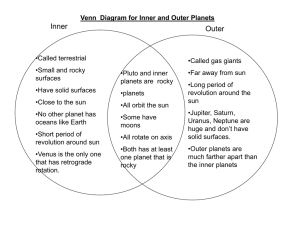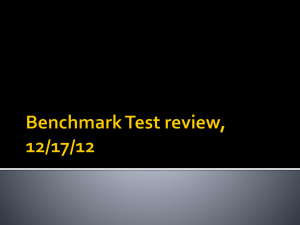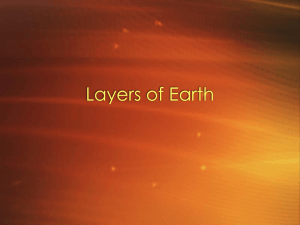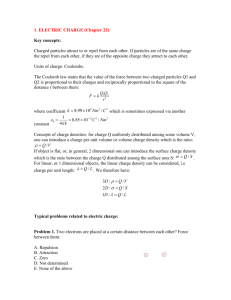PHYS 121
advertisement
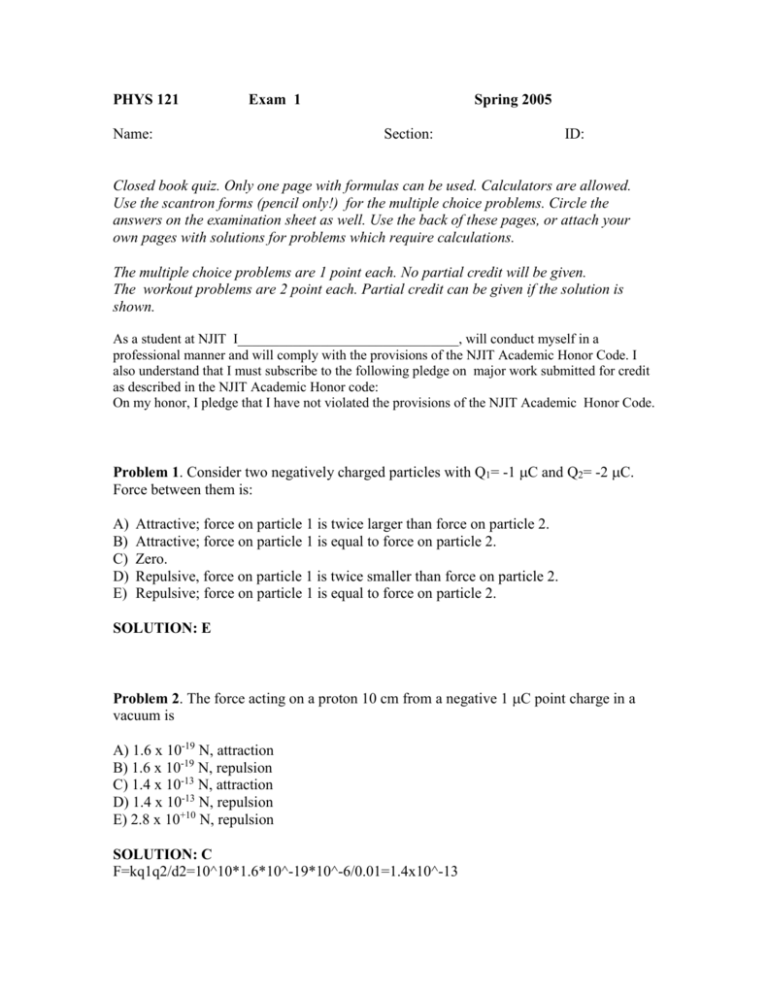
PHYS 121 Exam 1 Name: Spring 2005 Section: ID: Closed book quiz. Only one page with formulas can be used. Calculators are allowed. Use the scantron forms (pencil only!) for the multiple choice problems. Circle the answers on the examination sheet as well. Use the back of these pages, or attach your own pages with solutions for problems which require calculations. The multiple choice problems are 1 point each. No partial credit will be given. The workout problems are 2 point each. Partial credit can be given if the solution is shown. As a student at NJIT I________________________________, will conduct myself in a professional manner and will comply with the provisions of the NJIT Academic Honor Code. I also understand that I must subscribe to the following pledge on major work submitted for credit as described in the NJIT Academic Honor code: On my honor, I pledge that I have not violated the provisions of the NJIT Academic Honor Code. Problem 1. Consider two negatively charged particles with Q1= -1 C and Q2= -2 C. Force between them is: A) B) C) D) E) Attractive; force on particle 1 is twice larger than force on particle 2. Attractive; force on particle 1 is equal to force on particle 2. Zero. Repulsive, force on particle 1 is twice smaller than force on particle 2. Repulsive; force on particle 1 is equal to force on particle 2. SOLUTION: E Problem 2. The force acting on a proton 10 cm from a negative 1 C point charge in a vacuum is A) 1.6 x 10-19 N, attraction B) 1.6 x 10-19 N, repulsion C) 1.4 x 10-13 N, attraction D) 1.4 x 10-13 N, repulsion E) 2.8 x 10+10 N, repulsion SOLUTION: C F=kq1q2/d2=10^10*1.6*10^-19*10^-6/0.01=1.4x10^-13 Problem 3. A small dust particle with mass m = 1 mg has an uncompensated electric charge of 10 electrons. Find the value and direction of the electric field which should be applied to the particle near the surface of Earth in order to keep the dust particle in equilibrium. Use g=9.8 m/s/s for the gravitational acceleration. A) 6.125 1012 N/C, up B) 6.125 1018 N/C, down C) 6.125 1018 N/C, up D) 6.125 1012 N/C, down E) 0 N/C SOLUTION: B E=mg/q=10^-6*10/(10x1.6x10^-19)=10^13/1.6 Problem 4. Two particles with equal charge of 14C but opposite sign, are held 1cm apart. What are the magnitude (approximately) and direction of the electric field at the point midway between the charges? Select the correct pair of answers: A) 0, no field B) 106 N/C, towards negative charge C) 106 N/C, towards positive charge D) 1010 N/C, towards positive charge E) 1010 N/C, towards negative charge SOLUTION: E E=2*kq/d2=2*10^10*14*10^-6/(0.005)^2=28/25*10^10 Problem 5. A dipole consists of two equal and opposite charges located on the vertical axis, as shown in the figure. The direction of the electric field at point P is - -Q a P A) a B) C) D) E) The electric field is zero at point P. SOLUTION: B + +Q Problem 6. An electric dipole is positioned perpendicular to a constant electric field which is directed from the left to the right. The initial dipole orientation is with the positive charge on the top and with negative charge on the bottom. What happens to the dipole after it is released? A) The dipole is oriented horizontally, negative charge on the left, positive on the right. B) The dipole is oriented horizontally, negative charge on the right, positive on the left. C) The dipole is oriented vertically, negative charge on the top, positive on the bottom. D) The dipole will move along the direction of the field. E) The dipole will be rotated infinitely and will not take any particular direction. SOLUTION: A Problem 7. Which of the following is true of the electric field intensity about an infinite charged plane? A) B) C) D) E) It varies directly as the distance to the plane It varies inversely as the distance to the plane It varies directly as the square of the distance from the plane It varies inversely as the square of the distance from the plane It remains constant SOLUTION: E Problem 8. A positively charged particle is placed in a uniform electric field directed East. What are the direction and the value of the acceleration which will be experienced by the particle if its charge is q=3 C, its mass m=1 mg, and the value of electric field E is 5 x10-6 N/C? Select the closest answer: A) West, 1.5 x10-8 m/s2 B) East, 1.5 x10-8 m/s2 C) West, 1.5 x10-5 m/s2 D) East, 1.5 x10-5 m/s2 E) North, 1.5 x10+3 m/s2 SOLUTION: D a=qE/m=3*10^-6*5x10^-6/10^-6=15x10^-6=1.5x10^-5 East Problem 9. A proton with mass m = 1.67 x 10 –27 kg is placed above very large positively charged plate lying on the ground. What should be the surface charge density on this sheet to keep the proton above the ground? A) 1.8 x 10-18 C/m2 B) 2.35 x 10-6 C/m2 C) 8.55 x 10-1 C/m2 D) 3.14 x 106 C/m2 E) 1.84 C/m2 SOLUTION: A sigma=2eps*mg/q= 2*8.85*10^-12*1.67*10^-27*10/1.6*10^-19=1.8*10^-18 Problem 10. Find the electric flux through a cubic Gaussian surface of the side a 1 m surrounding a charge of 3 C. A) 0.1 x 10-16N m2/C B) 6.1 x 10+5 N m2/C C) 2.6 x 10-11 N m2/C D) 8.1 x 10-9 N m2/C E) 3.4 x 10+11 N m2/C SOLUTION: E F=Q/eps=3/8.85/10^-12=3*10^11 Problem 11. A particle of negative charge q = -5 C is placed at the center of an isolated conducting spherical shell. What are the values and signs of charges that appear on the inner and outer surfaces of the shell? A) inner -5 C, outer +5 C B) inner 0, outer +5 C C) inner +5 C, outer 0 D) inner +5 C, outer -5 C E) inner 0, outer 0 SOLUTION: D Problem 12. Consider the previous problem, but the shell is charged with an extra positive charge of +5 C. In this case, what are the values and signs of charges that appear on the inner and outer surfaces of the shell? A) inner -5 C, outer +5 C B) inner +5 C, outer -5 C C) inner +5 C, outer 0 D) inner 0, outer +5 C E) inner 0, outer 0 SOLUTION: C WORKOUT PORBLEMS Problem A. Four particles are placed at the corners of a square with side of 1 cm. Two top particles have a positive charge of 3 C and two bottom particles have a negative charge of –3 C. What are the value and the direction of the field exactly at the center of the square? Draw a clear vector diagram and present all your calculations; write your answer in the space provided. Answer: direction magnitude Problem B. Two tiny conducting balls of identical mass m = 1 mg and identical charge q hang from non-conducting threads of length L = 1 m. Due to repulsion, the particles are separated from each other by a distance x = 10 cm (so that the threads form an angle of 5.73 degrees with each other). Draw a clear diagram which shows the balance of tension, electrical and gravitational forces. Calculate q. Answer:



